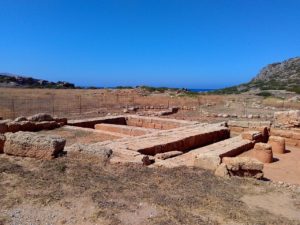
Ancient Phalasarna
Opening Times: Tue – Fri, 9:00 – 15:00
Free Entry
(as of summer 2016)

Phalasarna is the name given to the site of the city and harbour that once existed. The modern settlement is known as Falasarna. The excavations began in 1986 and have unearthed the fortifications, the quay and much more.
“Around the 8th to 7th centuries BC Dorians built a city over the ruins of a prehistoric site. The new city-state had laws, a complex system of social support, and cultural exchange with peoples of the East.
However continual wars against strong neighbouring city-states weakened Phalasarna, and frequent earthquakes and sea-level changes damaged the buildings and infrastructure. The citizens became pirates and stirred the anger of Rome. In 67 BC, Phalasarna was levelled by an invading Roman army determined to restore order to the Mediterranean sea lanes.
A new natural catastrophe in 365 AD, one of the greatest earthquakes in recorded history raised Phalasarna 6.5 m out of the sea in a few seconds, making its once-famous harbour forever useless while what remained of the city was flooded by a tsunami, buried in mud, and lost for another 1500 years.

Venetians who conquered Crete in the 13th century could not even find where Phalasarna had been located. A British traveller of the 19th century, T A B Spratt, found the city and its harbour 200 meters inland, but few believed him. Until 1986 when excavations began then under the direction of Dr. Elpida Hadjidaki, uncovering the towers and walls, surrounding the harbour, and eventually many of the harbour’s quays and jetties themselves.
The final irony is that the cataclysmic earthquake that moved the harbour 200 meters inland ultimately preserved it. The excavations have only begun to uncover this once glorious city, and no one can guess how much remains to be learned in the future.” Extracts from the phalasarna.weebly.com webiste – see the link below.
http://phalasarna.weebly.com/
The site has a short history and more detailed articles, plus some very good photographs.

It is produced by the Association for Friends of Ancient Phalasarna, which was founded in 2011. The President of the Association is the director of Phalasarna excavations, Dr Elpida Hadjidaki, who was responsible for rediscovering the site.
http://phalasarna.weebly.com/uploads/1/5/1/6/15165156/phalasarnabrochureenglish2010.pdf
This links to a PDF complete with map of the site.
The site of the harbour is now fenced off and is only open from Tuesday to Friday, from about 9.00 to 15.00. (this is the latest information for Summer 2016).
Many of the items from the site are now housed in the Kissamos Archaeological Museum – well worth a visit.

